LED House Light Fixtures
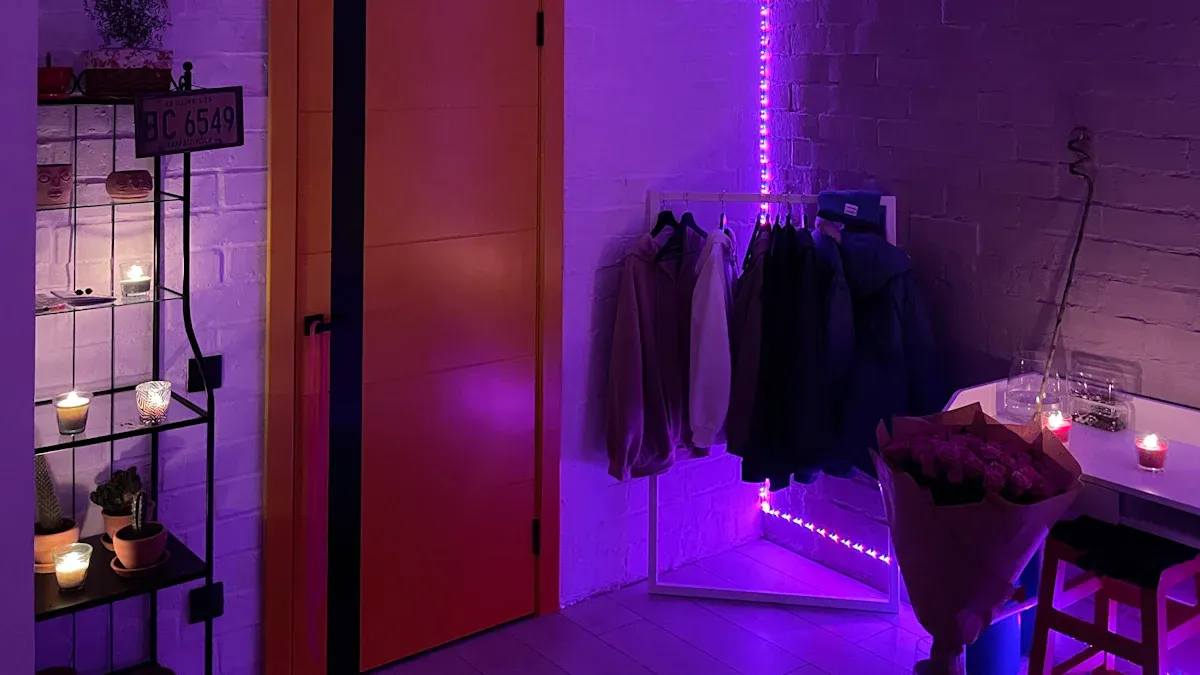
LED House Light Fixtures use advanced technology to brighten your home with less energy. You get a lighting solution that can last up to 100,000 hours—sometimes over 16 years if you use them for 10 hours each day. Many homeowners choose LED light because it cuts power use by up to 75% compared to older bulbs. You will also find more design options for every room. About Us and Product pages often highlight how these fixtures make your home both stylish and efficient.
Key Takeaways
LED house light fixtures save up to 85% energy and last much longer than traditional bulbs, reducing your electricity bills and replacement costs.
Choose LED fixtures with smart features and adjustable colors to improve comfort and save even more energy in your home.
Different types of LED fixtures fit various rooms and needs, such as ceiling, wall, recessed, under-cabinet, outdoor, and specialty lights.
Proper installation and maintenance, including safety checks and regular cleaning, help your LED lights work efficiently and last longer.
Hiring a professional for complex LED installations can save money, ensure safety, and help you get utility rebates faster.
LED House Light Fixtures Overview
What Are LED Fixtures
You use LED fixtures to light your home with advanced technology. These fixtures use light-emitting diodes (LEDs) instead of traditional bulbs. LEDs are small electronic devices that create light when electricity passes through them. You can find LED fixtures in many shapes and sizes, from ceiling lights to wall sconces and even under-cabinet strips.
LED House Light Fixtures have become very popular in recent years. According to the U.S. Energy Information Administration, the use of LED bulbs in American homes jumped from just 4% in 2015 to 47% in 2020 for most or all indoor lighting. This shows that more people want energy-efficient lighting. Higher-income and owner-occupied homes use LEDs even more. The market for residential LED lighting is growing fast around the world, especially in North America, Asia Pacific, and Europe. This growth comes from the need for energy savings, smart home features, and government support for efficient lighting.
You can see the cost-effectiveness of LED fixtures by comparing them to other types of bulbs. The table below shows how LEDs stack up against CFL and incandescent bulbs:
Feature | LED Bulbs | CFL Bulbs | Incandescent Bulbs |
|---|---|---|---|
Projected Lifespan (hours) | Up to 25,000 | 10,000 | 1,200 |
Wattage for Equivalent Light | 8.5 watts | 14 watts | 60 watts |
Cost per Bulb | $5 | $2 | $1 |
Electricity Used (kWh/25,000 hrs) | 212.5 | 350 | 1500 |
Electricity Cost (@ $0.10/kWh) | $21.25 | $35 | $150 |
Number of Bulbs Needed | 1 | 2.5 | 21 |
Bulb Expense for 25,000 hrs | $5 | $5 | $21 |
Total Cost for 25,000 hrs | $26.25 | $40 | $171 |
Household Savings vs Incandescent | $3,618.75 (for 25 bulbs) | $3,275 | $0 |
You can also see a visual comparison below:
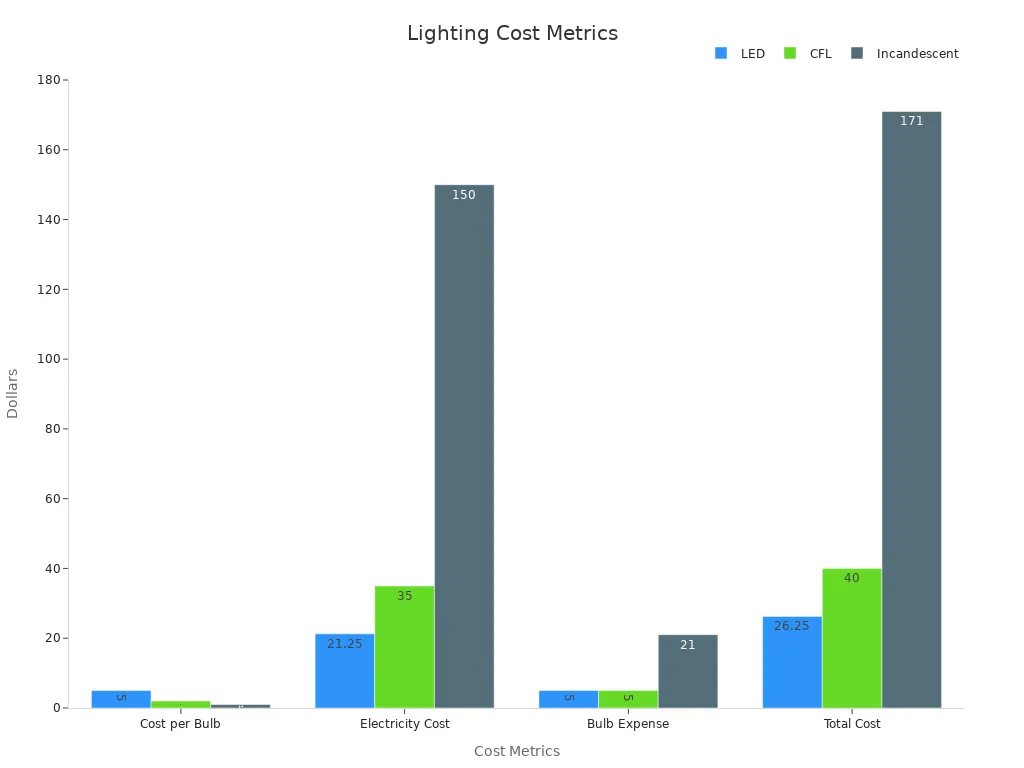
LED fixtures last much longer and use less energy than other bulbs. You save money on both electricity and replacement costs. LEDs also do not contain hazardous materials like mercury, making them safer for your home and the environment.
How They Work
LEDs work in a special way. You can understand the process by following these steps:
LEDs are solid-state lighting devices. They use a semiconductor to create light, not a vacuum or gas.
The semiconductor has two layers. One layer has "holes" (positive charge), and the other has free electrons (negative charge).
When you turn on the light, electricity flows through the semiconductor.
Electrons move from the negative layer to the positive layer.
When electrons meet the holes, they release energy as visible light.
Early LEDs were not very bright because some light stayed trapped inside the device. Scientists improved the technology by inventing efficient blue LEDs. This breakthrough made it possible to create bright white light for homes. The 2014 Nobel Prize in Physics went to the inventors of the blue LED, showing how important this step was for modern lighting.
LED fixtures use smart design to boost performance. Research shows that LEDs can reach over 150 lumens per watt, which means they give you more light for less energy. Many fixtures include heat sinks to keep the LEDs cool and extend their life. Some LED House Light Fixtures have smart controls, like motion sensors or daylight sensors, to save even more energy. You can also find fixtures that let you change the color of the light to match your mood or activity.
Tip: When you choose LED fixtures, look for options with smart features and adjustable color. These can make your home more comfortable and help you save even more energy.
LEDs turn most of the electricity they use into light, not heat. This makes them much more efficient than incandescent bulbs, which waste about 90% of their energy as heat. You get bright, cool light that is safe to touch and better for your electric bill.
Benefits
Energy Efficiency
You save energy every time you switch to LED House Light Fixtures. LEDs use much less electricity than traditional bulbs. For example, a study in Japan found that households reduced their electricity use by almost 2% after installing LEDs. If everyone switched, the savings could reach nearly 7%. Energy audits in factories show even bigger results. After upgrading to LEDs, one site saw a 60% drop in energy use. LEDs also beat fluorescent lights by about 44%. You get more light for less power, which helps the planet and your wallet.
Metric | Value |
|---|---|
Energy reduction after LED upgrade | 60% decrease in energy use |
Setting | Industrial manufacturing site |
Outcome | Improved lighting, safer workplace, cost savings |
Longevity
You do not have to change LED bulbs often. LEDs last much longer than other types of lights. Many can shine for up to 25,000 hours or more. This means you might not need to replace them for years. You spend less time on ladders and more time enjoying your home. LEDs also keep their brightness over time, so your rooms stay well-lit.
Cost Savings
Switching to LEDs lowers your bills. Many companies and homes report big savings after installing LED House Light Fixtures. For example, one manufacturer saved over $35,000 a year and cut energy use by 58%. Another company saved $66,494 in just one year. Some places saw payback in less than a year. You also save on maintenance because LEDs last longer and need fewer replacements.
A retail chain cut energy costs by 40% and made stores brighter.
A tech company used 35% less energy and improved worker comfort.
Parking garages and transit systems saved thousands each year and improved safety.
Safety and Comfort
LEDs make your home safer and more comfortable. They give off very little heat, so you do not risk burns. Studies show that safety levels for LED fixtures match other types of lights. What really stands out is comfort. People prefer LEDs with higher color temperatures, like 6500 K, because they feel more alert and comfortable. Good lighting helps you see better and feel better at home.
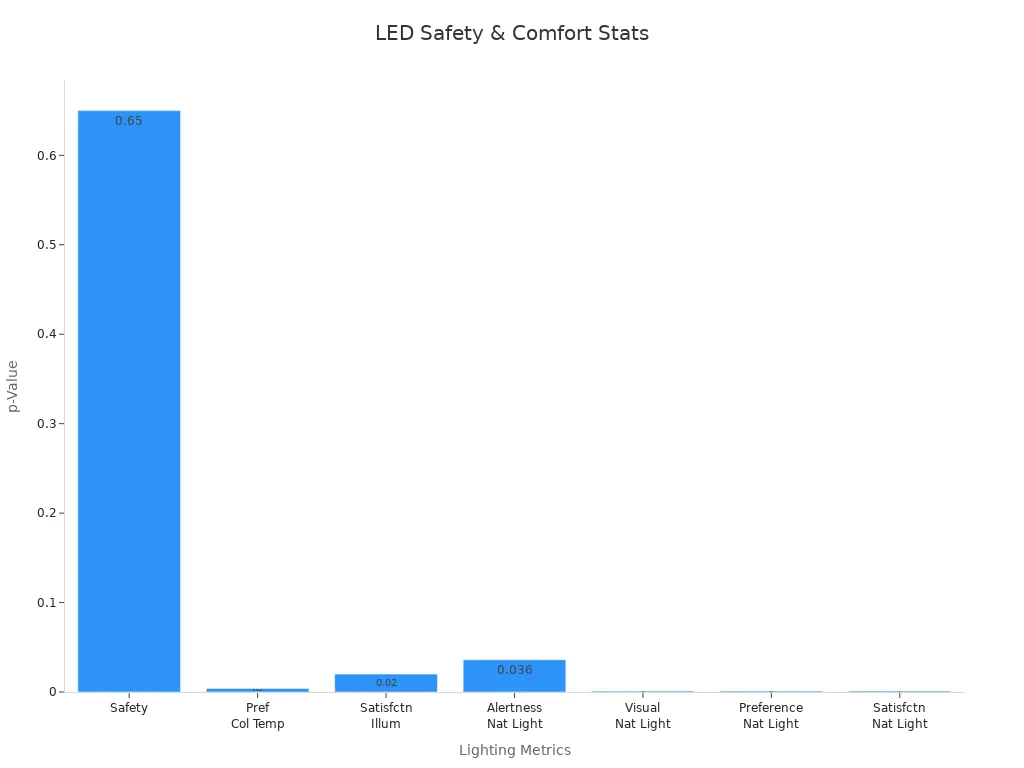
Tip: Choose LEDs with a high color rendering index (CRI) for the best color accuracy and visual comfort.
Types
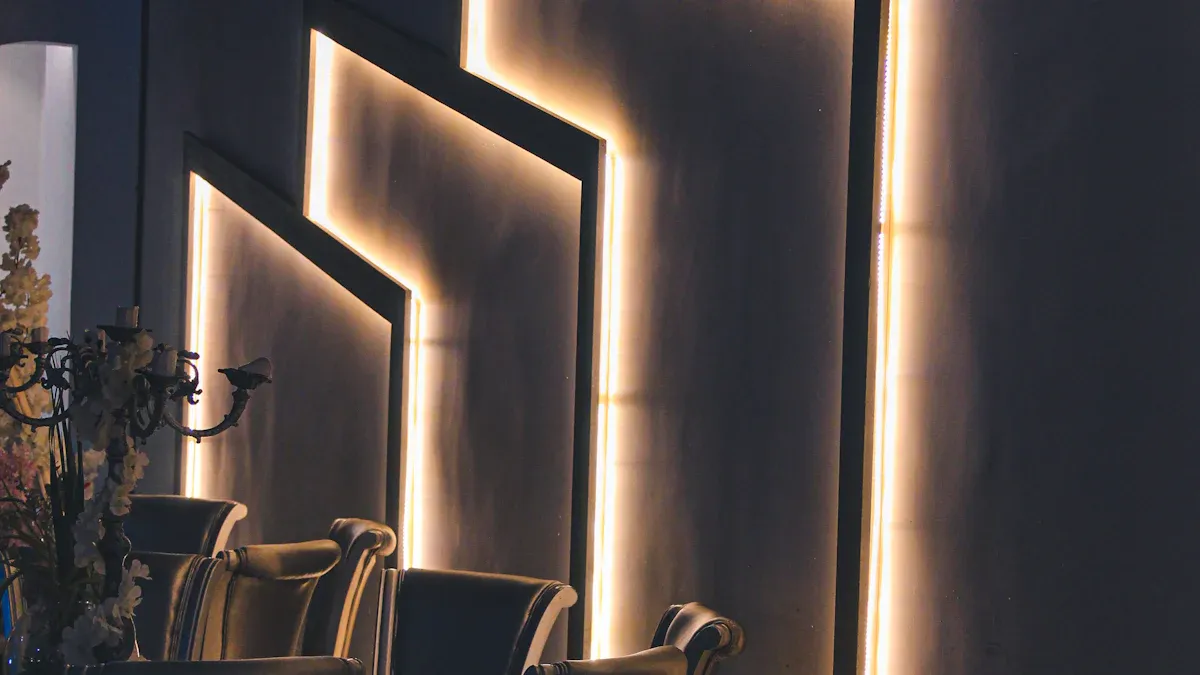
Ceiling Fixtures
You can choose from many ceiling fixture styles for your home. Common options include pendants, flush mounts, chandeliers, and track lighting. Flush mount LED lights sit close to the ceiling, making them perfect for rooms with low ceilings. They save space and offer a clean look. Pendant lights hang down and work well over dining tables or kitchen islands. Chandeliers add elegance to living rooms or entryways. Track lighting lets you point light where you need it most.
Here is a table comparing popular ceiling LED fixtures:
Fixture Model | Luminous Efficacy (lm/W) | Efficiency Highlights | Aesthetic/Design Benefits |
|---|---|---|---|
VISCOR Visioneering LRTP | 158.5 | High output, commercial-grade recessed | Modern style, wide lens, even light |
Elite Lighting: Oracle | 155.6 | Surface-mounted, high efficiency | Flush design, fits many rooms |
Metalux Cruze | 155.6 | Latch-less, matte finish | Architectural appeal, good price |
LED Green Light | 150.2 | High luminance, long life | Wide beam, high color accuracy |

Tip: Ceiling fixtures with integrated LEDs often last over 25,000 hours and use less energy than older lights.
Wall Fixtures
Wall fixtures give you flexible lighting for many rooms. You can install them in living rooms, bedrooms, hallways, or bathrooms. Wall-mounted lights save space and are easy to reach for cleaning or bulb changes. Many models let you dim the light or adjust its direction. You can pick from modern, classic, or decorative styles to match your home. Wall fixtures often use LED bulbs, which means you get energy savings and long life.
Wall fixtures are easy to install with basic tools.
They provide ambient, task, or accent lighting.
Dimmable and adjustable options help you set the right mood.
Many designs fit both small and large spaces.
Recessed Lighting
Recessed lighting sits inside your ceiling, giving you a smooth, modern look. These lights work well in kitchens, hallways, and living rooms. You can use them to highlight art or create even lighting across a room. Recessed LED lights can cut energy use by up to 80%. Proper installation is important to prevent air leaks and save on heating and cooling. Insulated covers help reduce air loss by up to 89%. Always use IC-rated fixtures for safety.
Aspect | Details / Figures |
|---|---|
Energy Use Reduction | Up to 80% less energy than old lights |
Air Leakage Reduction | 89% less with insulated covers |
Heating/Cooling Savings | Prevents up to 50% of ceiling thermal losses |
Under-Cabinet
Under-cabinet LED lights brighten workspaces in kitchens, offices, or workshops. You get focused task lighting that makes cooking and reading easier. These lights use up to 80% less energy than traditional bulbs and last up to 50,000 hours. You can choose puck lights for spots or strip lights for even coverage. Many under-cabinet LEDs let you adjust brightness or color. Some models offer smart controls for easy changes.
Low heat keeps your kitchen safe.
Long life means fewer replacements.
Aluminum channels and frosted covers reduce glare and protect the lights.
Outdoor Fixtures
Outdoor LED House Light Fixtures must handle tough weather. Manufacturers test them for corrosion, vibration, and wind resistance. Many models pass salt spray tests for coastal areas and meet federal rules for electrical safety. Outdoor LEDs last long, use little energy, and resist rust and water. You can use them for porches, walkways, or gardens.
Environmental Assessment | Description | Relevance to Outdoor LED Fixtures |
|---|---|---|
Corrosion Resistance | Confirms durability outdoors | |
Vibration Standards | ANSI/IEEE compliance | Ensures reliability in storms |
Wind Resistance | EPA measurement | Prevents fixture failure |
Electromagnetic Interference | Federal compliance | No signal problems outdoors |
Specialty Options
Specialty LED fixtures give you even more choices. You can find LED strips for accent lighting, tunable white lights for mood changes, and smart fixtures with motion sensors. Some LEDs offer UV-C disinfection or help plants grow indoors. These options use advanced technology for better color, energy savings, and custom control. Specialty LEDs work well in healthcare, retail, and creative spaces. You can adjust color, brightness, and even set schedules with smart controls.
Note: Specialty LED House Light Fixtures let you create unique lighting effects and meet special needs in any room.
Choosing LED Fixtures
Room Needs
You should start by thinking about how you use each room. Every space in your home has its own lighting needs. For example, you need bright, shadow-free light in kitchens and bathrooms for safety and tasks like cooking or grooming. Bedrooms and living rooms feel more comfortable with warm, soft light. Offices work best with focused task lighting and some ambient light to help you stay productive.
Use ambient lighting for general brightness in entryways and hallways.
Add task lighting, such as under-cabinet LEDs, in kitchens and workspaces.
Choose accent lighting to highlight art or special features in living rooms.
Layer different types of lighting to create the right mood and function.
You should also consider the size of the room, ceiling height, wall color, and how much daylight enters. Large rooms may need more fixtures or higher brightness. Dark walls absorb more light, so you may need stronger fixtures. If you want the best results, you can ask a lighting professional for advice.
Tip: Layered lighting helps you avoid shadows and creates a comfortable, safe environment.
Brightness & Color
Brightness and color temperature affect how you feel and work at home. You measure brightness in lumens. More lumens mean more light. Color temperature, measured in Kelvin (K), changes the mood of a room. Warm light (2700K–3000K) feels cozy and works well in bedrooms and living rooms. Neutral light (3500K–4100K) fits kitchens and bathrooms. Cool light (5000K–6500K) helps with reading, hobbies, and detailed tasks.
Here is a table showing how brightness and color temperature impact lighting:
Parameter | Range/Values Tested | Key Findings |
|---|---|---|
Illuminance (brightness) | 300 lx, 500 lx, 750 lx, 1000 lx | 750 lx at 5000 K or 6500 K preferred for work; 500 lx at 5000 K best for comfort and less fatigue |
Correlated Color Temperature (CCT) | 3000 K, 5000 K, 6500 K | Higher CCT (5000 K, 6500 K) gives better comfort; 5000 K with moderate brightness reduces stress |
You may notice that people often prefer higher brightness and cooler color for work areas. For relaxing spaces, lower brightness and warmer color feel better. Some people like to adjust their lights based on the time of day or activity. Dimmable fixtures and smart controls let you change the light to match your needs.
Customizable lighting helps you feel comfortable and focused.
Women often prefer lower brightness and color temperature than men.
Preferences can change over time, so flexible lighting is helpful.
Style & Design
You can match your lighting to your home’s style. Modern trends include creative LED fixtures that act as art pieces. You see unique shapes, like geometric pendants or asymmetrical chandeliers, in many new homes. Ribbed-glass fixtures with built-in LEDs blend vintage and modern looks, perfect for kitchens and living rooms. Minimalist designs, such as recessed lights and hidden LED strips, keep your space clean and highlight architecture.
Motion-sensor LED panels add convenience and save energy.
Layered lighting with soft, diffused LEDs creates a warm, inviting feel.
Thin, flexible OLED panels offer a modern look and even light.
You can choose from many finishes and shapes to fit your taste. Some LED House Light Fixtures stand out as a centerpiece, while others blend in for a subtle effect. Always pick fixtures that match your furniture and color scheme.
Note: Stylish LED fixtures can improve both the look and comfort of your home.
Compatibility
You need to make sure your new fixtures work with your home’s systems. Many LED lights now include smart controls and networked features. The DesignLights Consortium sets standards for these systems, helping you find fixtures that save energy and work with other devices. Look for products that meet these guidelines for easy integration.
Safety and performance matter, too. Manufacturers test LED fixtures for electromagnetic compatibility, so they do not interfere with your other electronics. They also check for power quality and safety using industry standards.
Test / Standard | Purpose / Description |
|---|---|
EMC Testing | Makes sure LEDs do not disrupt other electronics in your home. |
Checks that fixtures stay safe after being dropped. | |
Integrating Sphere Test | Measures color, brightness, and power use to ensure quality. |
You can choose between fixtures with replaceable bulbs or integrated LEDs. Integrated LEDs last longer but may require full replacement if they fail. High CRI (Color Rendering Index) fixtures show colors more accurately, which is important for kitchens, bathrooms, and art spaces.
You can buy LED fixtures at major retailers, specialty lighting stores, or online. Always check for compatibility with your dimmers, switches, and smart home systems before you buy.
Tip: Look for fixtures with extended warranties and certifications for the best safety and performance.
Installation
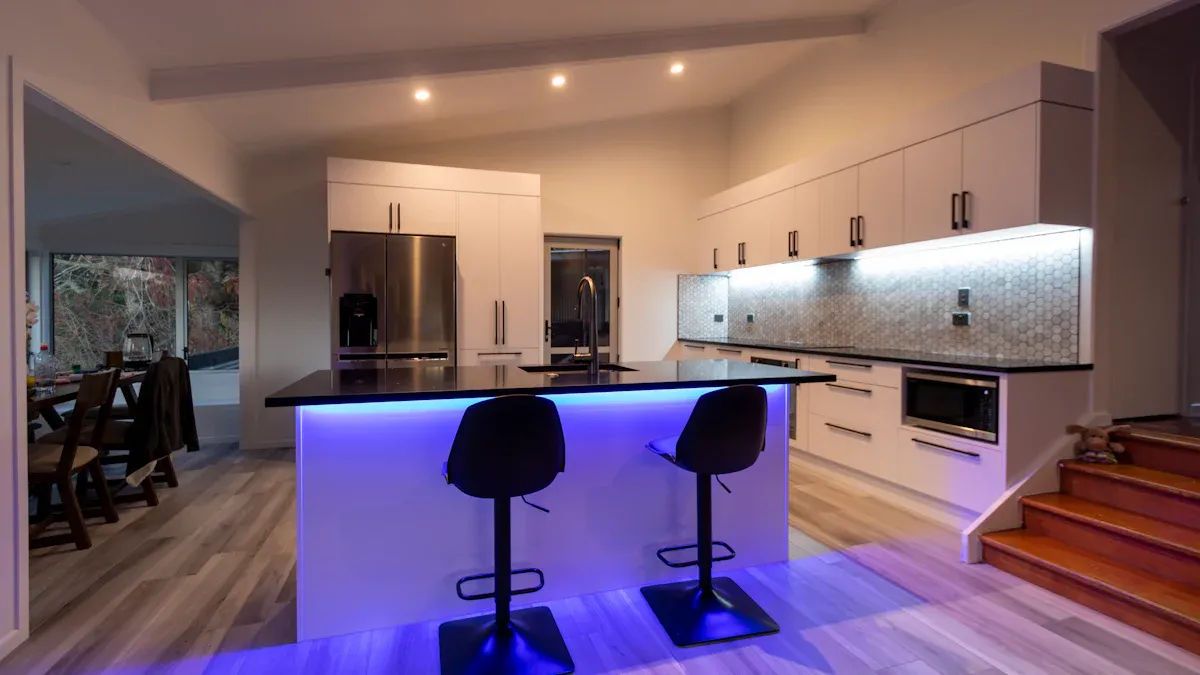
Safety Tips
You need to follow safety rules when installing LED fixtures. Always check that your fixture matches the room’s needs. For example, use fixtures with the right color temperature and IP rating for wet or outdoor spaces. Good thermal management is important. Choose fixtures with heatsinks and proper ventilation to prevent overheating. When working with electricity, turn off the power at the breaker box. Use the correct wiring and secure all connections. Pick transformers that match the LED load to avoid overloads and fire risks. Clean your fixtures regularly and replace any damaged parts right away. For health, select warmer color temperatures and flicker-free LEDs. In sensitive areas, use products with EMI suppression. Outdoor installations need weatherproof connectors and proper drainage to keep out moisture.
Tip: Always look for certification marks on your fixtures. These marks show that the product meets safety standards and is approved for use in your country.
DIY Steps
You can install many LED lights yourself by following clear steps:
Decide what kind of lighting you need and pick the right type of LED.
Gather tools like screwdrivers, wire connectors, and mounting brackets.
Draw a simple plan showing where you want each light and power source.
Turn off the power at the breaker box.
Remove old bulbs or fixtures and check compatibility.
For LED strips, measure and cut to size, attach with adhesive or brackets, connect to the power supply, and test.
For LED panels, mark the spot, mount brackets, secure the panel, wire it up, and test.
Set up smart LEDs by downloading the app and connecting to Wi-Fi.
Make sure you have good ventilation, use dimmers if needed, and avoid overloading circuits.
If you see flickering or dim lights, check your connections and power supply.
Note: Always double-check your work before turning the power back on.
Professional Help
Sometimes you need an expert for complex jobs. Professionals handle high-voltage systems and tricky site conditions safely. They know how to work with existing wiring, upgrade old systems, and use special equipment like lifts. Hiring a pro helps you avoid costly mistakes and ensures your installation meets electrical codes. Experts finish projects faster and often get utility rebates that you might miss on your own. The table below shows why hiring a professional can be a smart choice:
Installation Type | Annual Energy Savings | Payback Period | Fixtures Retrofitted | Utility Rebates |
|---|---|---|---|---|
Self-Installation | Moderate | 6.7 years | Fewer | Often missed |
Professional Install | High | More | Secured |
Hiring a qualified electrician gives you peace of mind, better safety, and long-term savings.
Maintenance
Cleaning
You keep your lights bright and efficient by cleaning them regularly. Dust and dirt can build up on lenses and covers, making your rooms look dim. Use a soft, dry cloth to wipe the surface of each fixture. For stubborn spots, use a damp cloth with mild soap. Always turn off the power before cleaning. Check for cracked covers or loose parts as you clean. Clean fixtures last longer and give you better light.
Tip: Clean your fixtures every few months to prevent dust buildup and keep your home shining.
Replacing Parts
You may need to replace parts if your lights start to dim or stop working. Some fixtures let you change the bulb, but many modern designs use integrated LEDs. If an integrated LED fails, you often need to replace the whole fixture. This can cost more than just changing a bulb. Always check your warranty before buying a new fixture. Choose fixtures with replaceable parts if you want easier maintenance.
Here is a quick checklist for part replacement:
Turn off the power at the breaker.
Remove the cover or lens.
Check if the bulb is replaceable.
Replace the bulb or the entire fixture as needed.
Reattach the cover and turn the power back on.
Note: Integrated fixtures offer longer life but may require full replacement when they fail.
Troubleshooting
You can solve many lighting problems with a few simple steps. If a light flickers or will not turn on, check the wiring and power supply. Look for burnt-out bulbs, faulty wiring, or dimming diodes. Make sure the fixture is sealed and weatherproof, especially outdoors. Inspect for dust, cracked housing, or water damage. Address small issues early to avoid bigger problems later.
Regular inspections help you spot trouble before it gets worse.
Fixing minor issues saves money and keeps your home safe.
Well-maintained lights reduce downtime and improve energy efficiency.
Keep a maintenance schedule to ensure your lights work well for years.
You gain many benefits when you choose modern lighting for your home. LEDs save up to 85% on energy, last much longer, and keep your space safer and more comfortable. See how these features compare:
Benefit Category | Statistic or Feature |
|---|---|
Energy Efficiency | Up to 85% less energy use than old bulbs |
Lifespan | 35,000–80,000 hours, up to 25 times longer |
Maintenance Advantages | Durable, less heat, fewer repairs needed |
User Control & Comfort | Dimmable, instant on/off, smart home ready |
Safety Improvements | Low heat, low voltage, safer for families |
Upgrading also brings real savings. Many homes and businesses see payback in just one to three years, with better lighting and lower bills.
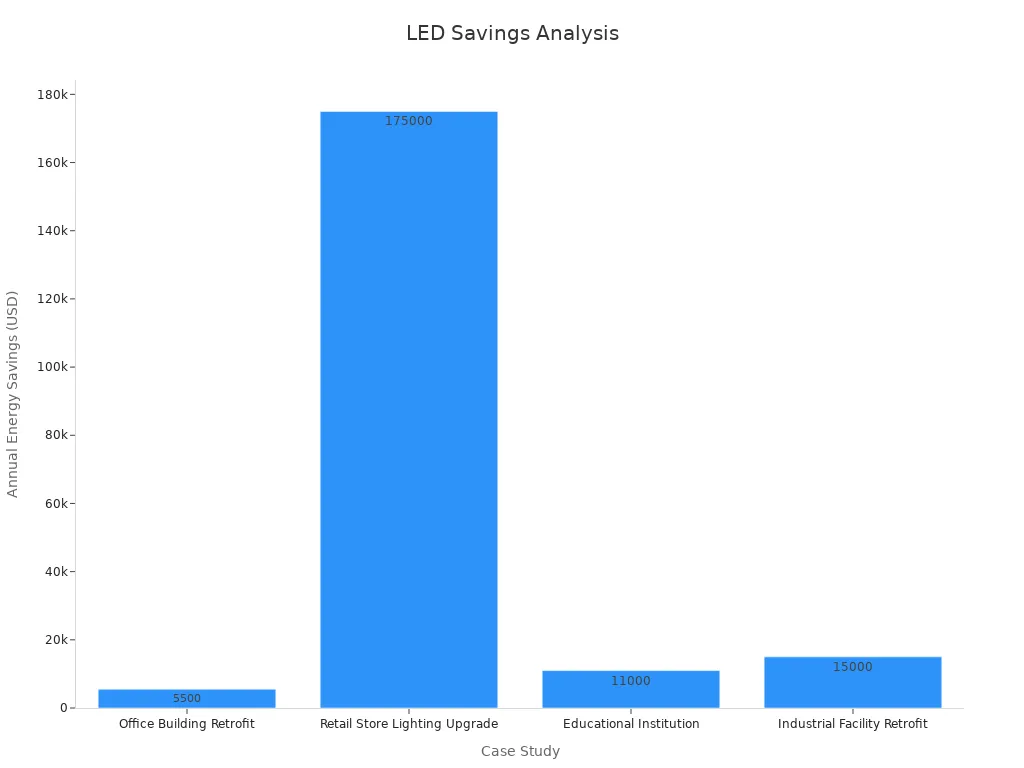
You can pick, install, and maintain these lights with ease. Start your upgrade today and enjoy a brighter, safer, and more efficient home.
FAQ
How long do LED house light fixtures last?
You can expect most LED fixtures to last between 25,000 and 50,000 hours. Some high-quality models reach up to 80,000 hours. You will not need to replace them often.
Can you use LED fixtures with dimmer switches?
Yes, you can use many LED fixtures with dimmer switches. Always check the packaging or product details. You need a compatible dimmer for smooth performance.
Are LED lights safe for your eyes?
LED lights are safe for your eyes when you use them correctly. Choose fixtures with diffusers and avoid staring directly at bright LEDs. Look for lights labeled as flicker-free for extra comfort.
Do LED fixtures work outdoors?
You can use LED fixtures outdoors if they have weatherproof ratings like IP65. These models resist rain, dust, and temperature changes. Always check the label before installing outside.
What should you do if an LED fixture stops working?
First, turn off the power. Check the wiring and connections. If the fixture uses replaceable bulbs, try a new one. For integrated LEDs, you may need to replace the whole fixture. Always follow the manufacturer’s instructions.
See Also
Effective Solutions For Indoor LED Lighting Needs
A Guide To Selecting Ideal LED Lights For Homes
Step By Step Guide To Installing LED Downlights
Enhancing Displays With Specialized LED Case Lighting
Understanding LED Replacement Lights: Varieties And Advantages

